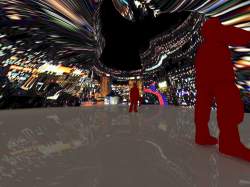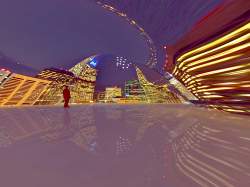Republic of Change / a dialogue
by Jeanne-Marie Gescher , CGA, Beijing, Philip Dodd, director Made in China
在西方,关于创意产业的夸夸其谈已经渐渐平息,社会的大规模城市化以及异军突起的个体化都成了中国发展中强有力的口号。然而在政府的控制之下,无论是创意还是城市空间,它们是否能超越口号本身仍是问题。
改变中的共和国
媒体在全世界范围内都可以说得上是政府强有力的工具,“创意城市”作为对革新思想的比喻,已经不仅是用在对创意机构的活动上了,而且也用在商业、社会和政府之间的基础关系上。跃过发展中地区,创意城市的概念给跨越传统模式和利用网络下的经济提供了一个机会。创意城市的理想好像几乎就是给中国制造的,因为这个国家面对21世纪的挑战所作出的整个反映,就好像是在震惊和敬畏之中的一个练习。现代中国到处都是个体和集体之间的竞争,死板与灵活之间的矛盾,标准与传统的冲突,以及统一和独立之间的斗争。永久的物理性空间是斗争的一部分,但绝不是全部。对改变甚至是豪无常性的高度忍耐中也有呼声、行动和个体性。处在改变中的人民共和国,还有什么能比这更有创意呢?
People's Republic of Change
From media buzzword of the late ‘90s to essential policy focus for ambitious governments around the world, the “creative city” has become a metaphor for innovative thinking not only about creative sector activity, but about the fundamental relationship between business, society and government.
‘what makes a particular city … innovative?’ 1
Across the developing world, creative city concepts are seen to offer the chance to leapfrog traditional (linear) models and embrace the power of the networked economy. Point-to-point networking with a focus on connectivity rather than high-rise; urban regeneration for inspiration as much as economics; “freedom” and “democracy” as principles of economic organization as much as political ideals — have all driven a blurring of the divides that traditionally separated the public-private-NGO spectrum.
多个朋友,多条路
‘the more friends you have, the moreopportunities you get’
Creative city ideals seem almost made for China — a country whose whole response to 21st century challenge seems to be an exercise in shock and awe. Images of Chinese urban chic emerging against a communist canvas has created an ever increasing stream of creative city tourists, all seeking their own fix on what has become the fastest-changing piece of the planet — where contradictions are the norm, and creative inspiration is almost guaranteed. City-state connectivity is accelerating, and many of China’s cities are acquiring a whole new sense of what it means to be Chinese — and creative. As other parts of the world have shifted their perspective to city as ecosystem, China’s creative city focus is arguably an essential step in re-crafting relationships between business, government, and society – and in so doing, coming to terms with that last frontier of the truly market economy: the individual.
the socialist market economy
Within China, creative city themes are acquiring a force of their own. Governments, from central Beijing to downtown Shanghai, and from rural Guizhou to poetic Chengdu, are discovering that while public budgets alone cannot meet need, private sector investment tapping into creative aspirations can deliver very real returns – as much for city branding as for rents. Even more astonishingly for those traditionally focused on the high-rise emblems of global wealth, the legacy deserts of yesterday’s industry seem to be custom-built for inspiration, innovation and the low cost knowledge environments that emerging creatives (creative entrepreneurs as well as enterprising creatives) crave.
‘city-branding has become a top priority in all Chinese cities’
probably China will incubate some of the most creative cities on the planet
So what does this mean? Well, quite probably that China will — depending on your definition of “creative” — incubate some of the most creative cities on the planet. Some may be slickly creative — hubs of commercial creativity serving the world’s fastest growing advertising market across a consumer market which is quickly expanding beyond the limits of the obvious metropolises of Beijing, Shanghai and Shenzhen. Some may be creative in focus, but not necessarily origination or style — policy-driven “games village” equivalents of the original high-tech zones. Some, like Shanghai’s Xintiandi and Beijing’s 798* , will be heavily branded and privately developed zones selling creativity for residence, work and roads — delivered side-by-side with hospitals, schools and hubs for entertainment, recreation and knowledge. Some could well be independent reclamations of urban wasteland. In so doing, they could dramatically push the boundaries of the traditional relationships between government, business, society and the individual.
‘Chaoyang District Government will develop cultural and creative industry parks and incubation centers’ 4
How many? which models? what impact? Hard to say, but present indications are that China 2010 could be a very different place. While central planning may still be around, on-the-ground diversity is likely to be a defining feature of the People’s Republic of Change. Shanghai’s Xintiandi and M50, Hangzhou’s Animation Park, Beijing’s Feijiacun Music and 798* Arts Villages, Nanjing’s Design Park, Lijiang’s Ancient City, Chengdu’s Games & Film Park and a host of others are likely to be but the forerunners of a host of innovative approaches to the creative city challenge. As they emerge, they will be accompanied by top-down blueprints and by a host of private urban developments which will be wired for online connectivity but may challenge the limits of exclusion.
‘from cotton to canvas …’ 5
‘digitize the future …’ 6
‘creation 100’
Will creativity survive? As the cost of urban living and working goes up, the independent elements of the creative class are likely to find it increasingly hard to compete with more affluent business tenants. Can the industrial wastelands reclaimed by creative independents survive against the commercial ambitions of would-be developers? The risks are clear but sharp government focus in certain parts of the country may deliver strengthened policy environments to even the playing field. Beijing’s Chaoyang District (recently designated as a national model for creative cities) is beginning to look at 798* almost as a heritage environment – exploring ways in which affordable access can be maintained by the state as a means of protecting the inherently independent nature of the area.
“不买房运动”
‘refuse-to-buy-apartments movement’ 8
Will it be creative? As government policy makers engage — whether through the design and delivery of custom-made “creative” zones or through the subsidization of independent creative spaces and “plans” and “plan-driven-funding” for the creative sector (by no means a made in China phenomenon) – can creativity remain creativity? Clearly, a struggle. The most recent (11th) Five Year Plan contains a plethora of policy targets at both the central and local level — from strengthening the policy (and regulatory) environment itself, to promoting resource co-ordination, as well as strengthening training and education, building pilot projects and “centers of excellence”, and expanding global trade initiatives and enterprise and related employment. But the collision of the official and the independent could well be a process to which China may bring an element of creativity all of its own.
‘the emergence of creative clusters around China’s cities has given the people a chance and a place to explore their individuality’ 9
Contemporary China is all about the struggle between the individual and the collective, between rigor and flexibility, between rules and tradition, between conformity and independence. Permanent physical space is part of the struggle, but by no means all of it. It is also about voice, presence and individuality, with a high tolerance for change and even impermanence.
The People’s Republic of Change. What could be more creative than that?
Note
1. Sir Peter Hall, Cities in Civilization (Pantheon Books, 1998), p.3
2. Chinese proverb: ‘the more friends you have, the more opportunities you get’
3. Su Tong, vice secretary general, Created in China Industrial Alliance (CCIA), 2006, www.ccia.net.cn
4. Chaoyang District Government, 2005
5. Motto for Shanghai’s M50 Suzhou Creek art district
6. Motto for Shanghai’s Xuhui digital district
7. Motto for Qingdao’s high-tech creative development zone
8. Slogan of the ‘refuse-to-buy-apartments movement’: potential apartment buyers across China are petitioning against the rising prices of apartments by refusing to buy, cf. www.notbuyhouse.com, www.ztlm.net
Dialogue
Talking creativity
Jeanne-Marie Gescher — Philip Dodd
JMG: Culture and creativity are now being recognized as significant economic drivers: economic sectors in their own right but also critical connectors to a wide range of urban “must haves” — not least the branding, tourism and sense of creative identity needed to attract and retain human as well as financial capital. True to the contradictions of the socialist market economy, we now have a five-year plan (the 11th) which is putting innovation at the heart of official endeavor and encouraging key cities to see themselves as beacons of culture and creativity for wider economic and social gains. Beijing has become a focal point of official ambition — in no small part because its creative independents have turned areas such as 798* into the poster childs of China’s “flash” (as in transformation at the speed of light) economy.
PD: My own sense is that we need to understand the crisis that has generated the new belief, from London to Beijing, in the creative economy. Manufacturing has withdrawn from the great cities and both for intelligent reasons and for reasons of desperation, cities are designating themselves as creative cities. The truth is, if all cities are creative, none are. How does a city differentiate itself in this dash toward creativity? It’s clear, isn’t it, that in the Darwinian struggle over creativity there will be winners and losers? Hence the fascination, in China and elsewhere, with cultural branding. Those that brand well will survive: such is the belief. And of course, it’s important that the brand reflects to some degree the reality. In London the opening of the new gallery of international art, Tate Modern, and the opening of the Eye, a large wheel on which you can travel and see the whole of the city, have become iconic images of London — for the local population as much as anyone else. In a globally competitive environment for creativity, effective, globally recognized branding is a key indicator of success. As yet, Beijing has no iconic image of its creative modernity (although the Olympics stadium or CCTV may become that).
The truth is, if all cities are creative, none are
JMG: The cultural revolution generation of tourists (looking for bicycles, Mao’s red book and Tiananmen Square) is now being replaced by a new generation which can best be described as “shock of the new”: 798 — now a compulsory point on the tourist map — is but one of a range of destinations chosen for their “China is not what you think” appeal.
PD: Culture is also more and more important to the tourist industry. More and more people travel as cultural tourists — and visit Europe not only to experience the history of culture but also contemporary culture. 59% of visitors cited museums as an important reason for visiting London in the 1991 census; 34% for the performing arts. Often the creative industries provide the soft infrastructure of tourism development (tourism is the biggest industry in the world) — the small arts-orientated enterprises that create local fashion, small consumer goods, galleries, shops, stylish bars and cafés that city visitors enjoy visiting independently.
JMG: Power no longer comes from the barrel of a gun but from a “speed of light” knowledge economy. As China’s formal curriculum has been recast to drive more and better learner-based learning and the creativity that goes with that, policy makers are moving on to recognize that neighborhood counts: knowledge hubs that center on universities need connectivity with creative talent — and both need access to business skills.
PD: In the new information age, creativity as a skill is more and more important. In the UK, there is now an increasing, if sometimes grudging, recognition that cultural subjects in the curriculum are important spaces in which people can learn to exercise creativity. Equally, there is a recognition, particularly at the university level, that cultural and creative students need business skills at the same time as it is recognized that business people need creative skills.
JMG: ‘Without destruction, there is no construction.’ 1 Construction and deconstruction appear to go hand in hand in contemporary China. Instant urbanization can be a temporary phenomenon and purpose driven zones are hostage to wider economic change which can occur quite quickly. Beijing’s 798 and Shanghai’s M50 are testaments to the fact that “economic adjustment” is not just a western challenge. What’s interesting however is that in an era of aggressive urban development, these spaces have managed to survive long enough for creative independents to get a foothold.
PD: Culture is a very good vehicle of urban regeneration — that, at least, is a common public sector perception. The large scale urban renovation carried out for the 1992 Barcelona Olympics created a new infrastructure, but the city authorities were concerned to ensure that local neighborhoods shared in the benefits by matching the international aspect of the Olympics with community-based participatory events involving the creative industries. In the Berlin Mitte, part of the old East Germany, abandoned buildings and low rents allowed small cultural businesses to move into the area. These small companies dragged other services in their wake, in the form of bars and cafes and restaurants — reinvigorating the area and helping to regenerate it.
Above all culture has become of interest to governments and policy makers because it’s clearly now a major economic earner. Even in the most powerful economy in the world, the US economy, industries related to culture had overtaken aircraft manufacture as the biggest export earner, employing over 10% of the population.
JMG: Contemporary China as “shock” is becoming a global theme. For China’s urban populations, 25 years of relentless change have created an extraordinarily adaptive youth generation — and one which is fascinated by its own experience. Prices of Chinese art works may be going through the roof in New York but here at home, creative expression — and interest in creative expression — is a social phenomenon in which the individual is finding his or her place in a world that changes everyday.
PD: In an increasing complex world where traditional notions of family and community and even nation are being reformulated, and where all of us recognize that all communities are “imagined communities”, culture is increasingly the space in which people discuss who they are and might be. In this sense culture will become ever more important.
JMG: China is now actively developing creative city — and sector — policies. Policy work is taking place both at the central and local government levels but — as in other parts of the world — it tends to focus on the numeric, the definable and the profitable: what can be counted; what can be seen and what drives GDP. There is of course a recognition that the total fabric is what counts — museums and events as much as design and TV — but at the end of the day, policy makers are captive to their own limited architecture.
The future belongs in the long run to city states rather than nations
长远的未来属于城邦而不是国家
PD: No one, anywhere, has adequately resolved how governments and policymakers should relate to the creative sector, imagined as an economic power. The reasons for this are numerous. At one level, there is the complex historical relationship between ideas of “commerce” and “culture” — which has been imagined as an antagonistic one. Of course this is historical illiteracy. Shakespeare was in our terms a millionaire when he died; Hollywood is the biggest historical experiment between art and big business, according to that impeccable left-wing critic, Manny Farber.
JMG: So possibly the socialist market economy — embracing rather than resolving the contradictions of policy and the market — is a pretty honest perspective.
PD: There’s very little convincing historical evidence to help us understand why creativity is fuelled in certain places and in certain times — so there is hesitation about what authorities should do. Once I was in Downing Street in London at a political seminar on the creative economy. At the end, a minister stood up and said: ‘I see what governments need to do: nothing — stay out of the way.’ Maybe he was right, or wrong. But one understood his bemusement.
At the same time, the conditions in which ideas of a creative city are nurtured are so various that it may be hard for different cities to learn from one another. St Petersburg has invested heavily in creative businesses for reasons of tourism. The authorities there believe that cultural tourists (and this is the kind all cities want as they spend the most money) want a landscape of creative businesses, a creative quarter, that they can “discover”. In St Petersburg, a creative quarter is nurtured to complement existing tourist attractions such as the Hermitage.
Sheffield in England was a world famous steel town which wanted a cultural initiative to help to provide employment as manufacturing left the city. But the public sector was so concerned with production that it forgot to ask what consumers there were for this production. Unfortunately, the answer was not enough.
In short it is important to stress that the issues that China faces have not been “solved” elsewhere. That doesn’t mean that cross cultural analysis isn’t important. It is. But policies can’t be imported like cars. They need to be culturally sensitive.
JMG: Policy makers often use the terms “culture” and “creativity” interchangeably but with significant differences in meaning — typically the cultural is attributed to traditionally state driven activity, while creativity is attributed to the independent sector; and while policy reform appears to favor convergence, the reality remains that these are two very different platforms. To complicate things (at least in terms of the number of policy-making institutions involved!), both culture and creativity are being absorbed into wider policy initiatives around knowledge — embracing the full spectrum of intellectual capital with a particular focus on science and technology. Complicated though it may be on the ground, the recognition of a link between these three — culture, creativity and knowledge — favors a very sharp focus on China’s traditional “intellectual” hubs where intense education resources (including universities which are well on their way to becoming global intellectual powerhouses) are co-located with enterprise and independence. It also (potentially) attaches China’s increasingly powerful technology engines around the digital distribution of content to the creation of content — and interactivity — itself. Search could well be re-invented here. And that’s just the beginning.
PD: My guess — if I’m ruthlessly honest with myself — is that for too long creativity has been seen to be the domain of culture. And yet in the 21st century, it is science entrepreneurs and biotech companies — the best of which are defiantly creative — that are going to be much more important to national economies and the global economy than the cultural one.
But let’s for the moment take the question you raise. For a start, if the creative economy is to be the driver of creative cities — and my view is that the future belongs in the long run to city states rather than nations — then there will need to be a radical overhaul in education. For instance, there are major universities in China as well in the US which are potentially hubs of creative enterprise. But is the education they are offering their students informed by the creative economy that they will join? My own view is that I doubt it. And that is only to talk about universities. What about schools. Should it be a right to have an education with a mouse (i.e. computer) as much with a musical instrument. How can entrepreneurship be taught? Can it be taught? The industrial revolution in the west transformed education. Who is thinking about the changes the knowledge economy will demand of education? Never forget that academics feel that they have property rights over not only knowledge but the way the knowledge is transmitted. That will have to be given up.
JMG: At a senior policy level, the link between creativity or culture and entrepreneurship is critical. It goes to the heart of job creation — for a country which (depending on which numbers you look at) will need to create 400 million jobs by 2020. The trick is to harness the element of independence to engines of practical skill, capital, and markets (at home and abroad) which, at present, is a very hit and miss process. The Club concept that you set up at the Institute of Contemporary Arts seems to have enormous potential to kick-start these linkages.
PD: When I was the Director of the Institute of Contemporary Arts (1997–2004), I commissioned with the political think tank Demos some short term “action-focused” research to discover what are the needs of the creative sector were. Once we had published the research — and the process from commissioning the research to publishing the research took only six months — we had to decide what to do next. One option was to prepare some more research. But we wanted to do something more immediately useful for the companies themselves that our research had shown were desperately in need of particular kinds of practical help. In response to these needs, I set up an informal “club” for these companies, to provide them business advice, whether on branding or on venture capital, and above all an opportunity to meet other companies whom they might wish to collaborate with.
One of the key characteristics of this sector is that companies often work in partnership. The companies ranged from fashion designers with only two employees to digital companies with 150 employees. In character the companies ranged from music labels and design companies (from fashion to product and industrial design), to PR companies and architectural practices. Above all The Club was a self-help group costing little money where knowledge and expertise was shared. It was run on behalf of the members, by myself, and an assistant. But it emphatically belonged to the members, and the seminars and events were driven by their needs. Sister clubs were instituted in Amsterdam, Glasgow and Taipei. The Club was, I suppose, an example of what the sociologist Manuel Castells means by the network society.
Part of the intellectual fascination of the creative economy sector and of creative cities is that neither the public sector nor private sector has quite managed to understand them. The public sector is wary of the companies because they make profits (when they can), so the public funding bodies have not been able to recognize them within their categories; yet the traditional representatives of private business have not provided them with support because they do not act or look like either financial or manufacturing businesses.
JMG: Independently reclaimed 798 seems to have become the latest tourist hotspot even as the world gets prepared to descend on an Olympic Beijing whose design is far more “made by government”. This extraordinary collision of the “unplanned” and the “planned” seems to have become an element of creativity in and of itself. Beijingers (who are as much 798 tourists as foreigners) could be forgiven for feeling slightly schizophrenic but they seem to take it in their stride. This “change is BAU” is one of the most distinctive characteristics of the city (and much of the rest of China) and something that seems to give the city a definite edge in terms of “creative” (read, adaptive, intuitive) thinking.
PD: I am excited by the change that I see in China — and I’m here once a month! I have no doubt that through the 21st century China will become more and more important as a creative producer. In the early 20th century, there was an American population hungry for entertainment and Hollywood came along to meet that need. In the great cities of China there is a population hungry for entertainment — and Chinese (and other) companies will arise to meet those needs — especially in the digital domain.
But I am equally aware that not everyone benefits from creative cities, or from the massive change that is transforming China. So how can the benefits of creative cities spread beyond a small elite (I hasten to say that this is not only a question in China)? I’m not fond of Richard Florida’s The Rise of The Creative Class because it seems to be a Leninist book (the vanguard) but without the politics. If change produces creativity then how can those excluded from the benefits of creativity be included in the story? This is for me a key question.
JMG: Our world (in China) is dominated by the online and mobile environments. China has 420 million mobile users — increasing by 4 million a month; 111 million online users — expected to be 232 million by 2010; and an estimated 16 million bloggers at Q4, ’05 — expected to be in the region of 60 million by Q4, ’06. The Beijing municipal government is working with the private sector to integrate the use of wireless technology into daily life. The “built” and the “virtual” are being created hand in hand with huge implications for reach and connectivity — within China and abroad.
PD: The impact of mobile phones simply hasn’t begun to be registered. But mobile phones are at another level simply a metaphor for the network society, to use Manuel Castells again. Creative businesses are often better known abroad than at home — and generate global networks. I brought 15 UK creative businesses to China in 2000; 7 of them have continued to work with/network with their Chinese counterparts.
But the most important dimension of the mobile and online world is the rise of “user generated content” — the shift to a democratic idea of creativity. A creativity not of the few but of the many; dialogue rather than monologue.
JMG: One of the things we work quite hard at is networking small creatives with global (and sometimes just pure foreign) business — a challenge given the architecture of the global (even global creative) businesses. Language, work styles, time and distance all add a particular “Chinese characteristic” to this. European governments, increasingly anxious to build not just large but small business links with China, are developing policy programs which may not hit the target. Training more Europeans in the Chinese language and in Chinese business practice does not necessarily address the most fundamental boundary which is that few Europeans have got on the ground experience of working in a small Chinese creative — and vice-versa. Language is a huge barrier but so is pure familiarity.
PD: Most of the time most of us are volunteered into doing what we do. So I’m not sure abstract initiatives are what will work. The last 20 years have been about the west moving east. I set up my company Made in China because I think that the next twenty years will be about China moving west. Chinese notions of aesthetics, of lifestyle, will become more visible in the west. So in that sense China will come to be as much in the west as the west has been in China. In these new circumstances, new ways of cross-cultural collaboration will begin to develop. The west will begin to notice that one of its greatest pieces of music, Mahler’s Das Lied Von Der Erde, is based on six Chinese poems; Chinese stories (such as the ‘Monkey King’) will begin to percolate into western imaginations. I think that all revolutions are long revolutions and that the kind of revolution of understanding you want will take time.
JMG: We are often asked why China is focusing on creative cities when the global zeitgeist is all about ecocities and networking for sustainability. My own view is that the two are closely related and that without exploring creative fundamentals (independence, networking, and collaboration) real ecocities are hard to achieve. China’s energy around creative cities (policy-driven and independent) seems to us to be a key factor in changing the relationship of the city to the planet.
PD: I’d like to believe that creativity and sustainability go together. But I see no reason they necessarily should do so. Between creativity and sustainability are the large mass of the population who are excluded from the creative economy and suffer the pains of a polluted planet.
I’m haunted by a phrase of an English novelist of the late nineteenth century, Thomas Hardy. He wrote, ‘when the poor have the power to choose between culture and luxury, they always choose luxury first’. I recognize this in the history of my own family. If creative cities, the creative economy, and sustainability are to mean what they might, they need to heed the words of Thomas Hardy and think how the benefits of creativity can be shared, harmoniously.
Note
1 Mao Zedong, May 16, 1966
Jeanne-Marie Gescher has lived and worked in Beijing since 1989; she is the founder of CGA, advisors to global business and government on the digital and creative sectors in China, and facilitators of a wide range of digital and creative dialogues within and around China, including (together with Made for China) the Creative Cities Network. In 2000 she was awarded an OBE in recognition of her work in building dialogue between the UK and China.
Philip Dodd has been described by the UK Guardian newspaper as ‘one of the two cleverest analysts of the political and cultural changes of his generation’. Formerly Director of the Institute of Contemporary Arts and an award winning BBC broadcaster, he is chairman of Made in China, an agency developing cultural, educational, and commercial projects between China and Europe. He is also creative director of China Now, a UK-wide 2008 festival devoted to China’s contemporary culture, and advisor to Beijing’s Chaoyang government on creative industries.
Team: Neville Mars

PDF proposal for Shenzhen Biennale 2009 - Golden Inflation
Video of scale mock-up Golden Inflation model
INSTANT LANDSCAPE TM 速成景观 TM
Cities like Beijing, Guangzhou and Shanghai will, at a certain point, overwhelm even the staunchest urbanite. The highways will morph in your mind from helpful escape routes into a tangled web of concrete slowly tightening around your neck. Finding refuge, as one would in London’s many great parks, or New York’s Central Park, proves morehttps://burb.info/nodes.php difficult and less satisfying than hoped or anticipated. Instant LandscapeTM was conceived to tackle precisely this problem, providing a natural scenery in the most barren pockets of the city. A green backdrop in a concrete jungle.
像北京、广州和上海这样的城市终会让最顽强的都市客透不过气来。在你的脑海里,高速路将从帮你逃离城市的路径变成勃颈上越缠越紧的纠结的混凝土网。要说寻找避难所的话,在伦敦有很多很漂亮的公园,或者纽约的中央公园,但事实证明它们也比所希望所期待的更为麻烦,且更少满足感。速成景观TM旨在精准地解决这一问题,在城市最荒芜的地带,营造自然的景观,是混凝土丛林的绿色背景。
Originally designed as a pavilion for the uncannily harsh assembly of the Shanghai Expo, the structure responds in a very direct way to the theme of ‘better city, better life’. Each mountain in the Instant Landscape building represents a major city in China. The width of each hill illustrates the population size, the height is an indication of the speed of growth of a particularly city. The entire structure becomes an building-size diagram investigating the state of China’s urbanization. Seeing the array of the most prominent cities lined up it becomes clear that size alone isn’t everything. The big three of China can expect serious competition over the next few decades.
设计方案最初是上海世博会异常生硬的场馆集合中的一座,建筑希望直接回应世博会的主题——“城市让生活更美好”。速成景观的每一座山头代表的是中国的一个大城市。山体的宽度的是人口规模,山头的高度是城市的发展速度。整个结构则是建筑体量的图表,试图呈现中国城市化进程的现状。当你看过最有名头的城市一字排开时,你会发现城市的大小并不代表一切。中国最大的三座城市在今后的几十年内将面临严峻的竞争。
About two thirds of hills are simply reinforced soil. While five big hills are hollow, structurally ideal cone shapes that contain the exhibition spaces. At first a static building, the project has evolved to become a temporary structure that can be set up in different places in different cities offering a instant green refuge where most needed.
三分之二的山头都不过是夯实的泥土,而五个大型山头是中空的,锥形的理想结构提供了展示空间。最初不过是静止的建筑,项目已经演化成为灵活的结构,能为最有需求的不同城市的不同地点提供速成的绿色避难所。
Preliminary sketches
links:
Architecture of Hi-tech:
-http://fett.ethz.ch/uia/index.htm
UIA atlas: The architecture of the future
-http://www.aia.org/aiarchitect/thisweek08/0229/0229d_lincoln.cfm
Lincoln Schatz’s digital video and external space
-http://www.aia.org/aiarchitect/thisweek08/0229/0229d_schaar.cfm
Completely natural house by Leed
-http://www.designboom.com/weblog/read.php?CATEGORY_PK=&TOPIC_PK=2223
Polish pavilion for shanghai expo in 2010
Architecture of New-idea:
-http://www.architecture2030.org/2010_imperative/webcast.html
Some solutions of Architecture from 2030 global warming
Other notes:
http://www.boeing.com/news/releases/1999/news_release_990903.html
-about FIA
Owned by neville mars / Added by neville mars / 17.5 years ago / 64075 hits / 4 hours view time
Tags
Latest Entries
Contribute
Login to post an entry to this node.
































